Vacuum Actuator
Vacuum Actuator
A number of high-tech processes must take place in a vacuum environment which places a unique set of constraints on precision positioning systems. Vacuum actuators are traditionally measured in Torr (1 mm of mercury, or 1/760 of atmospheric pressure). The degree of vacuum can vary widely, from low vacuum (.01 to 1 Torr), through medium vacuum levels, to high vacuum (10-5 to 10-7 Torr) and ultra-high vacuum (10-8 Torr and below).
Solutions for Your High Vacuum Positioning System Needs
The challenges presented in designing a vacuum actuator are two-fold: while it is important that the positioning stage doesn’t outgas and corrupt the vacuum level, it’s also important to ensure that the operation in vacuo doesn’t damage the stage (through overheating, for example). In the absence of air, convective cooling is no longer available and heat sources must be carefully managed.
The primary heat source in a positioning system is the motor, whether it be for a vacuum compatible linear stage or rotary. There are a variety of strategies available to reduce and monitor its heating. These can include:
- Lowering the stepping motor drive currents while the motor is in position
- Limiting the acceleration or duty cycle
- Investing in a motor with higher Km—a motor with a higher Km will dissipate less heat for any given motion profile
- Using specialized stepper and servo drives to minimize hysteretic iron losses
- For the lowermost axis, a stationary motor coil can conductively couple through the wall of the vacuum chamber, but moving coil designs and upper axis motors are more challenging to control.
In high vacuum positioning systems, adding a motor-mounted thermal sensor is also important to allow the motor temperature to be monitored.
We can also provide specialized high vacuum electrical feedthroughs which simplify the task of routing stage cables through the wall of the vacuum chamber. (Figure 1)
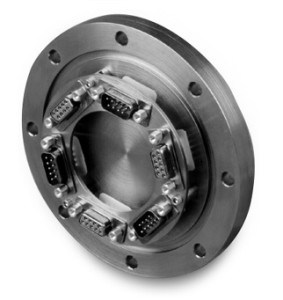
Outsmarting Outgassing
Conventional positioning tables include a number of outgassing sources which corrupt high vacuum positioning systems. Outgassing sources can include:
- Motors
- Lubricants
- Metal finishes
- Table materials
- Overall design
Our vacuum prepared stepping motors are extensively modified and incorporate 220 degrees Celsius magnet wire, Teflon leadwire insulation and lacing, and a specialized bearing lubricant. Similarly, our vacuum rated linear motors for our vacuum compatible linear stages include minimally outgassing potting compounds. All remaining materials are selected for high vacuum compatibility, and finished motors undergo a bake-out at 85 degrees Celsius for 8 hours at 10-7 Torr. The resulting outgassing rate is typically about 1 x 10-5 Torr-liters per second. This rate is multiplied by the pump speed in liters per second to determine the ultimate vacuum that can be achieved.
Lubricants are especially prone to outgassing, and if not properly selected, they may condense on critical optical or semiconductor surfaces within the vacuum chamber. We use specialized perflorinated polyether lubricants that achieve vapor pressures of 9 x 10-9 Torr at 100 degrees Celsius.
Water Vapor Retention and Outgassing
Oftentimes vacuum stage components are anodized which vastly increases the surface area of these components as well as their tendency to absorb water vapor. This entrapped water vapor then constitutes a virtual leak which may require hours or even days to pump away. Our vacuum compatible stages are finished with either an electroless nickel or Iridite plating that minimizes this water vapor retention.
In all of Dover Motion’s high vacuum position systems, trapped pockets of air are eliminated by vented, stainless steel fasteners that are used on all blind tapped holes. Any remaining cavities are similarly relieved to ensure a rapid pump-down, and Teflon insulated wires with fluxless solders are used on all connectors. A final three-stage cleaning process, followed by nylon-gloved assembly, further ensures a low overall outgassing rate.
Water Vapor Retention and Outgassing
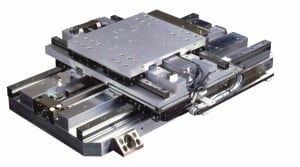
Figure 2 shows a high vacuum compatible linear stage for use in a scanning electron microscope for performing defect review on semiconductor wafers. The stage features vacuum prepared brushless servomotors, linear encoders, and vacuum lubricated recirculating crossed roller guideways and ball screws.
Figure 3 shows a very large six-degree-of-freedom, high vacuum stage that was designed to orient a 1200-kilogram NASA detector package during ground-based calibration of the AXAF (subsequently Chandra) orbiting X-ray observatory.
We are proud to have stages operating in an extremely high vacuum environment—outer space. A pair of specialized single-axis stages (Figure 4) launched in 1995 as part of the UVCS instrument on the SOHO satellite (SOlar and Heliospheric Observatory). They then took up residence at Lagrange 1, .1 million miles from Earth (4 times as far as the Moon).
Despite being designed for a 5-year mission, SOHO and our stages
are still going strong twenty years after launch. Special design features include:
- Space-rated, redundant coil motors
- Dual linear potentiometer
- Absolute position feedback
- A planetary gearhead
- Extensive light-weighting
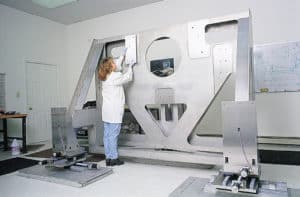
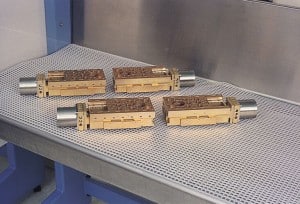
Vacuum Compatible Linear Stages
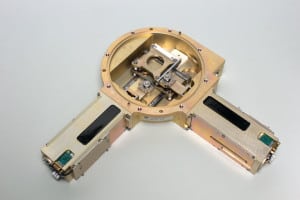
One example of our capabilities when it comes to designing solutions for high vacuum settings is the vacuum compatible linear stage seen in Figure 1. This XY stage was designed for very high vacuum MALDI-TOF systems using linear motor coils at atmospheric pressure and moving magnets located within the high vacuum chamber. Thin and thoughtfully deployed aluminum sections transmit the magnetic flux while being completely impermeable to air. This design vastly improved the motor coil’s heat dissipation, but also avoided any outgassing of the motor coil potting material even with aggressive motion profiles. This latter feature was critical in being able to meet the customer’s very high (1 x 10-8 Torr) vacuum linear actuator requirement.
Building the Right Vacuum Actuator
Dover Motion offers a variety of vacuum compatible standard products, and we also specialize in collaborating with our clients to configure the right motion solution for their unique application. With more than 50 years of experience in the life sciences, diagnostics, and factory automation industries, we understand your needs and industry and can provide you the flexibility you need to hit your cost and schedule targets. Contact us today to learn more about how we can help you with your next project.
